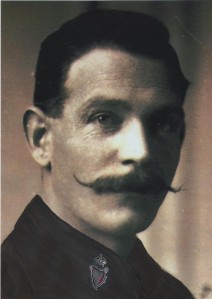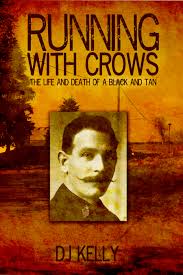 When the Black and Tans were first deployed in Ireland in March 1920, they soon proved themselves to be a pretty brutal bunch. They were liberal with the use of their rifles, were often drunk and even engaged in arson and robbery.
When the Black and Tans were first deployed in Ireland in March 1920, they soon proved themselves to be a pretty brutal bunch. They were liberal with the use of their rifles, were often drunk and even engaged in arson and robbery.
The Tans were ex-servicemen, many of them scarred from their time in the trenches during World War One. In my novels I write about such veterans and their difficulty in adjusting to post-War life.
From intimidation, to physical assaults to outright murder, they were a law unto themselves who sowed fear amongst the communities they patrolled. My own grandfather, who was involved with the IRA during the War of Independence, felt their wrath when once they used pliers to pull a fingernail from his hand during an interrogation.
But there is one Black and Tan who has a special place amongst their ranks. His name is Private William Mitchell (pictured) and he holds the dubious claim to fame of being the only Tan or British soldier to be hung for crimes committed while in Ireland.
I came across the story of William Mitchell through historian Denise Kelly, who has produced a fascinating book on him, called Running With Crows: The Life And Death of a Black and Tan. Kelly has conducted impressive research to tell Mitchell’s tale, from his upbringing in the notorious Monto area of Dublin, through to his service with the British Army in India, then in World War I and, finally, in Ireland.
Mitchell was one of the 20-odd percent of Tans who were actually Irishmen. His career in the military was chequered to say the least – imprisoned for insubordination while on the front line, he served his sentence before being injured during a German attack and was sent home.
Mitchell was a petty criminal who, it would appear, got too ambitious and bit off more than he could chew during a robbery at the house of a local magistrate in Wicklow. The robbery was bungled and the magistrate was shot dead.
Tan outrages in Ireland had up ’til then gone unpunished but such was the furore over their lawlessness that an example was decided to be set in this case. Mitchell denied any involvement, but he was charged nonetheless. A rushed trial, with rather dubious evidence, would see to it that he paid the ultimate price.
Denise Kelly’s book paints a detailed picture of Mitchell, from birth to death, and gives fascinating insights into slum life in Dublin and what soldiering was really like in the fading days of the British Raj.
Mitchell, who was hanged in Mountjoy Prison in Dublin in 1921, seems to have been cut from the same cloth as many of his fellow Tans. What Kelly has done, though, is to put a face and a real story to one of the most notorious paramilitary groups ever to stain the character of the British military.
William Mitchell’s body remains in the soil of Mountjoy to this day, unclaimed by any relatives. His story is typical in so many ways of his comrades, yet his final penalty means that he will always be the anomaly – the Tan who was executed by his own side. It’s not much as epitaphs go, but it is enough to ensure a peculiar kind of notoriety in a time when the gun and the bullet ruled the day.
More on the Irish War of Independence
Irish Rebel Maurice Meade: May You Live in Interesting Times
"The Blacksmith" Hammers the Auxies at Clonfin, Longford
Dillon’s Cross Ambush and the Burning of Cork City
Corkmen Capture Mallow Barracks
Ballymahon Barracks Attack: Arming the Boys of Longford
The Listowel Mutiny: “Shoot on Sight”
The Ballymacandy Ambush: "I would not turn off my road for any Shin...
Seán Treacy at War: Tipperary 'Far Away'
“Paddy” O’Brien and the Rathcoole ambush: Vengeance Is “Mine”
The Scramogue Ambush: Roscommon Steps Up
The 1st Brigade Cork Volunteers and the Coolnacahera Ambush
Michael Brennan and the East Clare Brigade at the Glenwood Ambush
100 Years Ago: The Piltown Ambush (1 November 1920)
Liam Lynch, Civil War Martyr: “It never should have happened”
“Tipperary’s Dan Breen: The Hardest Hard Man.”
'Greyhound on Train': Rescuing Seán Hogan at Knocklong
The Clonbanin Ambush: “To Hell With Surrender!”
George Lennon: Waterford Rebel
George Lennon & the Piltown Ambush
The Kilmallock Barracks Attack: Burning Down the House in Limerick
The Tureengarriffe Ambush: Cork & Kerry Strike a Blow
The Tourmakeady Ambush: Shrouded By the “Fog of War” in Mayo
The Headford Ambush: Time Runs Out in Kerry
Cataclysm in Cork: The Battle of Clonmult
“The Scourge of Tralee”: Stalking the “The Major”
The Dromkeen Ambush: Down Into the Mire in County Limerick
The Rineen Ambush: Hell Comes to County Clare
The Carrowkennedy Ambush, June 2, 1921: Revenge is a Dish Best Served Cold
Tom Barry: 'We May Have Great Men, But We’ll Never Have Better'
The Battle of Crossbarry: ... 'Who Piped Old Ireland Free'
The Kilmeena Ambush, May 19, 1921: Seeds of Victory in a Defeat
'Nigh Comeragh's Rugged Hills': Ambush at The Burgery
The R.I.C. In An Untenable Position, Part 1: Trauma at The Burgery
The Lispole Ambush -- Averting Disaster on the Dingle Peninsula
Patrick White: A Clareman's Tragic Death on Spike Island
'And To Watch the Sunbeams Dancing O’er the Wicklow Mountains High'
Always Remember ~ Cumann na mBan
War of Independence -- How the Nuns of Kylemore Saved My Father's Life
Terence MacSwiney: Irish Martyr
Walking to Work Through a Battle Zone
Review of 'Emmet Dalton - Somme Soldier, Irish General, Film Pioneer' by Sean Boyne
Ballinalee, County Longford: The Village of Generals
The Anglo-Irish Treaty: Seed of 'The Troubles'
Shot While Attempting To Escape
Easter Rising to Irish Civil War Archive Available Online
Michael Collins: Saga of Heroism Against Daunting Odds
A Short History of Michael Collins, Ireland's 'Big Fellow'
Great Irish Romances: Michael Collins and Kitty Kiernan
Kitty and Michael: a revolutionary courtship
The Tan Who Was Hanged By His Own Side
Liam Lynch: Victim of the Irish Civil War
After The Rising … 'Fron-goch and the Birth of the IRA'
Ernie O'Malley: Mayo-Born Freedom Fighter and Writer
The Wild Geese Virtual Síbín with Cormac O'Malley
Evidence Abounds: British Leaders OK'd Mayhem
The West Cork Trail: Scenes From the Anglo-Irish and Civil Wars, 1920-1922
How I Learned That Grandad Executed Erskine Childers
Leaders of the 1916 Easter Rising: Éamon de Valera
Erskine Childers: Author, Irish Gunrunner, Churchill's Bête Noire
The Scum of England, or Ordinary Men? A Review of DJ Kelly's 'Running with Crows'
The Forgotten Ten:

Heritage Partner
That's Just How It Was
My Grandmother often spoke about 'thetan' being more brutal that any men of war ; shooting ;maiming ; torturing people , for walking on the same side of the road as them .
In my tribute to her ; That's Just How It Was - I did to convey this message to readers.
A brutal bunch of misfits sent over to Ireland to Brutalise the Irish in their own country
Jul 7, 2015
Gerry Regan
"Running With Crows" author DJ Kelly is a long-time member of TheWildGeese.Irish. I suggest anyone interested in keeping in closer touch 'friend' her here. Fellow member and novelist John J. Gaynor has reviewed her book. We launched a discussion of 'Tans in the (Family) Closet,' which we re-present here.
Jul 7, 2015
David Lawlor
By all accounts the Auxiliaries were worse than the Tans.
I reviewed Denise's book myself, Gerry. It's a fascinating, well-researched story that gives a great glimpse into the slums of Dublin and into the Empire before it started to crumble
Jul 8, 2015
Gerry Regan
David, I wasn't sure if you intended your post here as a review. In any event, I'm sure Denise and other readers appreciate the additional perspective on her work and this history.
Jul 8, 2015
Claire Fullerton
Yes, I appreciated this piece, for it shed light on the Tans and was a wonderful review.
Jul 8, 2015
DJ Kelly
Sincere thanks, David.
That's praise indeed coming from the author of two well-written adventures set in the same era. I thoroughly enjoyed your 'TAN'. The main character was well-rounded and sympathetically drawn and the story was historically accurate and engaging. David writes highly readable blogs, too, folks. He has a knack for finding highly unusual and fascinating facets of history. David, you should post a link to your history blog page on here. I know others would enjoy your blogs.
Jul 8, 2015